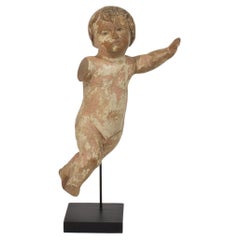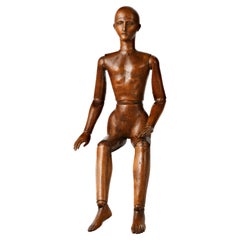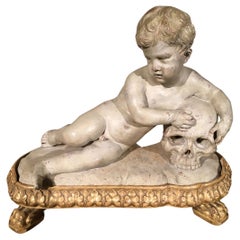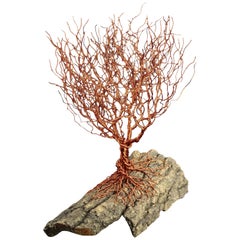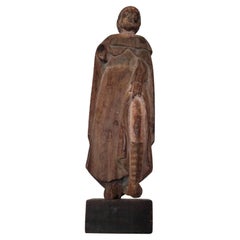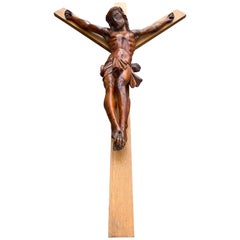Wood Figurative Sculptures
to
467
2,507
269
89
619
486
1,402
358
296
567
299
31
27
37
58
37
87
97
126
43
19
304
200
170
122
108
79
52
49
35
24
19
19
16
13
10
5
4
1
7,250
4,522
3,925
3,575
2,865
1,476
1,234
1,499
574
402
354
329
Height
to
Width
to
2,865
2,636
2,744
72
56
18
13
8
Material: Wood
Small Italian 18th Century Hand Carved Wooden Baroque Angel Fragment
Located in Buisson, FR
Beautiful small hand carved Baroque angel fragment. Unique period piece with traces of its old color .
Italy, circa 1750
Weathered. Several small losses.
Measurement here below inc...
Category
18th Century Italian Baroque Antique Wood Figurative Sculptures
Materials
Wood
$686 Sale Price
50% Off
19th Century Italian Wood Mannequin, Circa 1870-1880
Located in Milano, IT
Mannequin
Sculpted and carved wood
Italy or France, second half of the 19th century.
It measures 25.59 x 6.29 x 3.54 in (65.5 x 16 x 9 cm)
It weighs 2.2 lb circa (1 kg circa)
St...
Category
1870s Italian Other Antique Wood Figurative Sculptures
Materials
Wood
Memento Mori Late 17th Century Faux White Marble Child Skull Figure Sculpture
Located in Brescia, IT
This engaging sculpture of Memento Mori dated Late 17th Century, is part of a production of small terracotta figures for private use, which Giuseppe Maria Mazza, created throughout h...
Category
Late 17th Century Italian Baroque Antique Wood Figurative Sculptures
Materials
Terracotta, Giltwood
Aluminum Bonsai "Prickly Copper", Handmade in Italy, Sculpture, Contemporary
Located in San Miniato PI, IT
The Prickly Copper Bonsai is inspired by trees moved by a strong wind.
The materials are wood and metals, representing both the strength of life and the roots of Mother Nature.
Scu...
Category
2010s Italian Modern Wood Figurative Sculptures
Materials
Aluminum
17th Century Spanish Colonial Hispano-Philippine Carved Santo
Located in Forney, TX
A scarce 17th century Spanish Colonial carved wood santo with provenance from the National Museum of the Philippines Manila.
circa late 1600s
A large part of what makes this example so very rare is not just the age and condition, but the saint depicted, San Roque.
The Hispano-Philippine (Spanish-Filipinos) hand carved hard wood religious altar figure presents splendidly, with scattered remnants of original gesso and polychrome pigments, the exceptionally sculpted religious folk art depicting San Roque (Saint Roch or Rocco), the 14th century Catholic patron saint frequently invoked against the plaque, various infectious disease, as well as patron saint of dogs, invalids, of falsely accused people, and of bachelors, amongst others.
Provenance / Acquisition:
Retaining registration - identification label to verso from The Republic of the Philippines (RP) National Museum of the Philippines Manila with hand written registration number.
Acquired from highly reputable auction house, Austin Auction Gallery, est. 1982, Austin, Texas. February 2022 catalog.
Dimensions: (approx)
Overall: 15.75" High, 5" Wide, 4" Deep.
Figure: 14" High
1.5lbs
Great original antique condition, especially considering it's around 350 years old. Nicely aged patina over the whole. Presented on a later wood plinth base. Typical loss to right arm, minor finish losses, old tiny metal plate added to prevent age related splitting, all wear consistent with age, and only adds to the overall sophisticated character, authenticity, and charming rustic warmth that can only be acquired over long periods of time.
We here at Lynx Hollow Antiques absolutely love religious antiques, from an antique altar, church architectural salvaged building and ornamental elements, reliquary, tabernacle cabinet...
Category
17th Century Spanish Colonial Antique Wood Figurative Sculptures
Materials
Gesso, Hardwood
Large Size French Wall Crucifix / Jesus Christ on the Cross with Crown of Thorns
Located in Lisse, NL
Antique large size sculpture and an impressive, religious work of art.
Looking at Christ suffering like this, the crucifix (in our view) is a symbol of what 'telling people the trut...
Category
Late 19th Century French Gothic Antique Wood Figurative Sculptures
Materials
Wood
Chinese Carved Zitan Figure of a Bodhisattva, Qing Dynasty
Located in Austin, TX
A finely carved Chinese zitan wood figure of an unidentified bodhisattva, possibly Guanyin, late Qing Dynasty, circa 1900, China.
The androgynous figure has a plump, almost matronly face, with downcast eyes and a gentle smile. The hair in long tresses, gathered and tied in a high chignon.
The enlightened being is portrayed seated in dhyanasana, bare feet resting on crossed legs, both soles pointing up.
Thick robes billow and drape around the full figured body. The hands display...
Category
Early 20th Century Chinese Qing Wood Figurative Sculptures
Materials
Lapis Lazuli
Pair of Igorot Tribesmen Figural Hunter and Huntress Carvings, circa 1940
Located in Charleston, SC
Pair of Igorot tribesmen figural wood carvings depicting hunter and huntress with companion canines, weaponry, and displayed on circular fluted plinth...
Category
Early 20th Century Philippine Anglo-Indian Wood Figurative Sculptures
Materials
Mahogany
Hand Carved Wooden Female Torso Sculpture
Located in Toronto, ON
A hand carved wooden female figure torso. This sculptural figure is made out of Walnut tree which has been meticulously hand carved in the shape of a female torso. It's large in size with 24.5" inches height, 12" inches wide, and 9" inches depth (at the bust), 5" inches depth from the base. The bottom is the base is signed.
In overall good condition, it has some signs of wear on the such as scratches or slight damage on wood.
(Plinth used...
Category
21st Century and Contemporary Unknown Other Wood Figurative Sculptures
Materials
Wood, Walnut
$560 Sale Price
30% Off
Lwalwa Mother Figure Holding Baby DR Congo Africa with Provenance
Located in Atlanta, GA
A finely carved Lwalwa maternity figure holding a baby from Democratic Republic of Congo in Central Africa circa 20th century. The statue was acquired in 2006 from the collection of Jean-Pierre Hallet Collection of African Art.
The figure, with her robust body and a strong stand, wears a classic Lwalwa mask...
Category
Mid-20th Century Congolese Tribal Wood Figurative Sculptures
Materials
Wood
Mexican Dia De Los Muertos Day of the Dead La Catrina Folk Art Figure Sculpture
Located in Studio City, CA
A quite wonderful Mexican Day of the Dead (Dia De Los Muertos festival held throughout Mexico) La Catrina symbolic skeleton figure.
La Catrina is the festival’s most recognizable image/figure. She is the model of a high-society woman who has met Death, her maker. She represents something between the fear induced by her skeletal form and the revelry exhibited by the comical way she is typically portrayed, making her a perfect symbol of the Mexican holiday. She often appears in paintings, window displays, and costumes all around Mexico during the Day of the Dead festivities.
La Catrina was originally conceived in the early 1900s by newspaper illustrator and printmaker José Guadalupe Posada...
Category
20th Century Mexican Folk Art Wood Figurative Sculptures
Materials
Textile, Wood, Paper
Songye Female Large Wood Kifwebe Mask with White, Black, Provenance, DRC Africa
Located in Point Richmond, CA
Carved wood large female Songye Kifwebe mask with classic white lines, blackened ridge down crest of forehead, nose and mouth. Worn holes around back edge of mask from attachment of...
Category
Mid-20th Century Congolese Tribal Wood Figurative Sculptures
Materials
Wood
Italian 18th/ 19th Century Carved Giltwood Neo Classical Style bird Ornament
Located in Buisson, FR
Beautiful handcarved giltwood bird ornament.
Italy circa 1780-1820 . Weathered and small losses and old repairs
Measurements include the wooden base.
H:23cm W:41cm D:6,5cm
Category
18th Century Italian Neoclassical Antique Wood Figurative Sculptures
Materials
Wood
$471 Sale Price
50% Off
Late 19th Century Italian Wood Mannequin, circa 1880
Located in Milano, IT
Atelier mannequin
graven and carved stone pine wood
Italy, late 19th century
Measures: H 102 cm x 25 cm x 14 cm
H 40.15 in x 9.84 in x 5.51 in
Weight: circa kg 4
State of conse...
Category
1880s Italian Other Antique Wood Figurative Sculptures
Materials
Wood
Art Deco Madonna Holy Virgen Sculpture, 1920
Located in Saint-Amans-des-Cots, FR
French Art Deco Madonna Statue, 1920s Hand-Carved Oak Holy Virgin Sculpture. This exquisite French Art Deco Madonna statue dates back to the 1920s, expertly hand-carved from what ap...
Category
1920s French Art Deco Vintage Wood Figurative Sculptures
Materials
Oak
Virgin and Child in Majesty
Located in Saint-Ouen, FR
Virgin and child in majesty
Origine: castille
Epoque: early 14th century
Measures: Height: 72cm
Length: 30cm
Depth: 25cm
Polychrome and gi...
Category
15th Century and Earlier Antique Wood Figurative Sculptures
Materials
Wood
$41,802
19th-20th Century Orientalist Terracotta Bust of Girl Attributed to Goldscheider
Located in Los Angeles, CA
An Austrian 19th-20th century Orientalist terracotta bust of a young girl in Middle-Eastern Garb. The young smiling beauty wearing a head scaft and shawl tied with a broche-pin brooch pin and jewlry around her neck, raised on a circular ebonized wood stand. Probably by Friedrich Goldscheider (Goldscheider'sche Porzellan-Manufactur und Majolica-Fabrik) - The backside stamped: "T - No. 258". circa 1900.
The Goldscheider Manufactory and Majolica Factory (German: Goldscheider'sche Porzellan-Manufactur und Majolica-Fabrik, (now) Goldscheider Keramik) is an Austrian ceramic manufactory.
In 1885, Friedrich Goldscheider came from the small Bohemian city of Pilsen to Vienna and founded the Goldscheider Manufactory and Majolica Factory. It became one of the most influential ceramic manufactories of terracotta, faience and bronze objects in Austria with subsidiaries in Paris, Leipzig and Florence. For over half a century Goldscheider created masterpieces of historical revivalism, Art Nouveau (Jugendstil) and Art Deco. Famous artists such as Josef Lorenzl, Stefan Dakon, Ida Meisinger and the two perhaps best known Austrian ceramic artists Michael Powolny and Vally Wieselthier worked for Goldscheider. Several of the artists who worked for Goldscheider also worked for other Viennese studios, such as Augarten, Keramos or for the German brands Rosenthal and Meissen.
The Goldscheider family emigrated in 1938 to United Kingdom and USA. Walter Goldscheider startet a new factory in Trenton, New Jersey and returned to Vienna in 1950. Marcel Goldscheider went to Stoke-on-Trent and produced figurative ceramics for Myott and opened his own studio in the 1950s in Hanley. Both brothers died in the early 1960s.
More than 10,000 different models were created over a period of three generations. Since the very beginning many of these won first prizes and gold medals at innumerable world fairs, exhibitions and trade fairs. Goldscheider figures...
Category
Early 1900s Austrian Agra Antique Wood Figurative Sculptures
Materials
Terracotta, Wood
$4,547 Sale Price
29% Off
Italian Alabaster Bust of Girl Reading on Floor Pedestal
Located in Hanover, MA
Early 20th century Italian alabaster bust of a little girl reading a book standing on a period walnut pedestal column. Bust is apparently unsigned.
Bust
Height 14"
Width 10"
D...
Category
Early 1900s Italian Edwardian Antique Wood Figurative Sculptures
Materials
Alabaster, Marble
18th Century Carved Oak Statue Depicting St. Bartholomew
Located in Dallas, TX
This tall French statue of St. Bartholomew was hand-carved from oak in the 1700’s. This depiction of St. Bartholomew is not often seen in art, except for one of the most well known r...
Category
18th Century French Antique Wood Figurative Sculptures
Materials
Oak
Puerto Rican Santos De Palos/Wood Carved Sculpture of Our Lady of Mount Carmel
Located in Guaynabo, PR
A renown tradition in Puerto Rico is the making of Santos de Palos by Masters Carvers since the 19th century. They hand carved and hand painted the saints inspired in their personal ...
Category
19th Century American Folk Art Antique Wood Figurative Sculptures
Materials
Wood
$4,000 Sale Price
20% Off
Mid-Century American Folk Art Wood Articulated Man Figure
Located in Farmington Hills, MI
We are very pleased to offer a Folk Art wooden articulated man, circa the 1950s. This nearly 5-foot tall, handcrafted piece, epitomizing Mid-century American craftsmanship, is made ...
Category
1950s American Folk Art Vintage Wood Figurative Sculptures
Materials
Hardwood
Pair of 18th Century Italian Dancing Angels with Baroque Pearls on Aragonite
By Interi
Located in Dublin, Dalkey
Pair of 18th century Italian dancing angels with coordinating baroque pearls on aragonite crystal clusters.
The dancing angels are hand-carved wood, polychromed and gilded, original...
Category
18th Century Italian Rococo Antique Wood Figurative Sculptures
Materials
Rock Crystal, Gold Leaf
Exquisite Polychrome Spanish santo wood sculpture of St. Dominic
Located in Leesburg, VA
Exquisite Polychrome Spanish santo wood sculpture of St. Dominic
Anonymous
ca. 1700; Spain or the Spanish Americas
Polychrome wood
Approximate ...
Category
Early 1700s Spanish Baroque Antique Wood Figurative Sculptures
Materials
Wood, Paint
Romer italy hand carved desk top wall street stock market investor sculpture
Located in Ferndale, MI
Fun and nicely carved figure of wall street stock market investor . Complete in suit and tie with ticker tape machine . Hand carved in Italy late ...
Category
Mid-20th Century Italian Mid-Century Modern Wood Figurative Sculptures
Materials
Wood
Memento mori sculpture depicting a skull, Italy 1700.
Located in Milan, IT
Wunderkammer Memento Mori sculpture. depicting a skull, carved from a single piece of fruitwood, this sculpture depicts a skull with deliberately exaggerated and distorted proportion...
Category
Early 18th Century Italian Antique Wood Figurative Sculptures
Materials
Wood
Hermanos Calavera Jefe in Oiled Mahogany by Miguel and Ilse Silva for Wooda
Located in Omro, WI
These handsome but quirky brothers designed by Miguel and Ilse Silva for Wooda are the result of an engaging mix of personality, love, fun and mischievousness. Los Hermanos Calavera ...
Category
21st Century and Contemporary American Modern Wood Figurative Sculptures
Materials
Hardwood, Mahogany, Maple, Oak
15th Century Burgundian Low-Relief Depicting Scenes of the Nativity
Located in Saint-Ouen, FR
Provenance : In the same private collection for several generations, Burgundy.
The canonical Gospels describe briefly the episode of the Nativity. It comprises three parts :
• The Preludes : the Journey to Bethlehem, the Census
• The Nativity
• The Announce to the Shepherds and the Adoration of the Magi
Only the Gospel according to Matthew (2, 1-12) speaks about the Adoration of the Magi. Staying vague about their number it does say they brought the newborn gold, incense and myrrh. The apocryphals, the fathers of the Church and many other authors have filled in the gaps of the evangelic tale. The sobriety and symbolic of the story have been a huge inspiration to artists. Although one of the oldest depictions of the Adoration of the Magi dates from the 2nd century the theme became very popular in Christian art during the late 14th century. One of the reasons explaining this success is that it celebrates both the Virgin and Christ at the same time.
This important walnut panel is carved in a strong relief and depicts the different steps of the story of Jesus’ birth.
On the left, the donkey and ox that have accompanied Mary and Joseph from Bethlehem are depicted behind a trough. On the thatch roof appears the star that would guide the magi to the place of birth of Jesus.
Mary is wearing a veil and is seating on a bed. She holds her baby at arm’s length to present him to the magi. Saint Joseph is by her side. The old man is holding a cane in his left hand while from the right hand he seems to uncover himself to greet the visitors.
A woman assists to the scene.
In front of the holy family the three magi stand behind one another to pay their homage to the newborn.
The first magi has a pointed beard. He is already kneeling out of deference and has placed his crown to his feet. He gives the baby a hanap filled with gold coins. This is Melchior as the legend describes him with white hair and a long beard.
Caspar, the second magi bears a cup of incense. He is looking at the third magi and with his right hand he points to the star that has guided them there. He has a short beard and wears crakow shoes, breeches and a wide sleeved doublet.
Finally Balthazar, the elegant last magi proceeds proudly towards the holy family with his one hand on the saber’s hilt and the other holding a cup. He brings the divine child the myrrh. He probably just dismounted as the horse can be seen behind him.
The scene is set in a very detailed and narrative decor. In the right part of the panel the shepherd receive the announce of Jesus’ birth. An angel comes down from heaven with a scroll bearing the good news in his hands. The herding dog sleeps peacefully while sheeps graze. At the top of the cliff we notice the gilded sheeps enclosure.
The panel’s moulded frame is carved with a foliated decor. In it’s centre appears a coat-of-arms. It is the alliance of the three magi’s arms. Indeed as it was common for legendary figures the three of them received imaginaries coat-of-arms. Thus, on a field of azure stands a star for Melchior, a crescent for Caspar and a pennon for Balthazar.
This high-relief panel is undeniably the work of a very skilled and imaginative artist. This key moment in the New Testament is transposed to a contemporary environment thanks to the figures’ clothing and the rural daily life scene. This way the universal dimension of the episode is highlighted allowing a better understanding for the contemporaries.
The sculptor has represented the episodes of the Adoration of the Magi and the Announce to the Shepherd with great talent and numerous details giving life to a picturesque and narrative scene. The important traces of polychromy give those already very animated scenes a stronger pictorial power and a rich dynamism.
Because of the picturesque and familiar realism so dear to the artists of the late Medieval era, of the didactic function of this type of panel as well as the quality of the sculpture this piece is an astounding example of Burgundian art of the 15th century.
Literature
Louis Réau, Iconographie de l’Art chrétien...
Category
15th Century and Earlier French Gothic Antique Wood Figurative Sculptures
Materials
Walnut
Brutalist Hammered Metal Tree Sculpture with Uplight, Curtis Jere, 1960s
By Curtis Jeré
Located in Lambertville, NJ
Mid-Century Modern metal tree sculpture by Curtis Jere. This tall dimensional botanic floor tree features torched gold brass metal leaves on natural wood st...
Category
1960s Mid-Century Modern Vintage Wood Figurative Sculptures
Materials
Stone, Metal
$2,240 Sale Price
52% Off
Midcentury Postmodern Steel and Wood Coat Stand in the Shape of a Man
Located in Doornspijk, NL
This playful Postmodern coat stand is not only a smart space saver in a hallway, pantry or dressing room, it is also a pleasant and cheerful interior e...
Category
Late 20th Century Dutch Post-Modern Wood Figurative Sculptures
Materials
Steel
Japanese antique wood carved Buddha/1800s/late Edo period/folk Buddha
Located in Sammu-shi, Chiba
This is a wooden Jizo Bodhisattva statue made in the late Edo period in Japan.
It is thought that they were not carved by Buddhist sculptors living in central cities such as Kyoto or...
Category
19th Century Japanese Edo Antique Wood Figurative Sculptures
Materials
Cypress
Strong Marka Antelope Human Mask Wood with Metal, Mali Africa
Located in Point Richmond, CA
Strong Marka antelope - human wood mask with metal, Mali Africa. Large square open eyes, long nose with horizontal lips, three projecting brass metal braids ending with feathered cl...
Category
Mid-20th Century Malian Tribal Wood Figurative Sculptures
Materials
Wood
Japanese Antique Wooden Buddhist Figure, Edo Period '1603-1868'
Located in Hitachiomiya-shi, 08
This antique wooden Buddhist figure was crafted in the Edo Period (1603–1868).
Although the specific identity of the deity it represents is unknown, the figure has a gentle presence...
Category
Mid-17th Century Japanese Edo Antique Wood Figurative Sculptures
Materials
Wood
Vintage Antique Carved Wooden Folk Art Horse, c.1940
Located in London, GB
A wonderfully carved hardwood statue of a jumping horse. c.1940
Slightly naïve but full of charm whittled from hardwood. Beautiful detail throughout. Obvious loss of one rear leg. M...
Category
Early 20th Century English Wood Figurative Sculptures
Materials
Hardwood
Exquisite Wooden Cherub Head with Glass Eyes, c. 1800
Located in Hamburg, DE
This finely carved wooden cherub head, dating back to around 1800, is a remarkable example of German craftsmanship. Unlike many similar pieces, this putto remains in its original, un...
Category
Early 1800s German Baroque Antique Wood Figurative Sculptures
Materials
Wood
1980s Italian Bronze Riace Warrior Sculpture Statue Signed Pintoneilo
Located in Miami, FL
1980s Italian Bronze Riace Warrior Sculpture Statue Signed Pintoneilo
Offered for sale is a circa 1980s bronze statue of the older Riace Warrior sculpture. This bronze is extremely ...
Category
Late 20th Century Italian Classical Greek Wood Figurative Sculptures
Materials
Bronze
Wood Low-Relief Depicting a Werewolf and Saint George
Located in Saint-Ouen, FR
Exceptional polychrome wood low-relief depicting a werewolf and saint george after a woodcut by lucas cranach (“DER WERWOLF” 1512)
Provenance :
collection Brimo de Laroussihle
colle...
Category
16th Century German Renaissance Antique Wood Figurative Sculptures
Materials
Wood
Vintage African Fertility Pregnant Woman Wood Carved Floor Sculpture
Located in Keego Harbor, MI
For your consideration is an incredible, African fertility woman, wood carved floor sculpture, with an attached acrylic base. In excellent vintage condition. The dimensions of the sc...
Category
20th Century Wood Figurative Sculptures
Materials
Wood
Pair of Large 18th Century Hand Carved Angel Statues
Located in Sag Harbor, NY
This is a pair of jaw dropping hand carved angles. Each figure is carved with an individual face and pose. Removed from a Church in Europe and brought to the States in the 1990's. Th...
Category
Late 18th Century French Baroque Antique Wood Figurative Sculptures
Materials
Hardwood
Six Bronzed Wood Decorative Columns
Located in Hanover, MA
Set of six decorative Ionic and Corinthian columns made of carved wood that has been accentuated with bronze colored leaf.
These were used as merchandising display props at Boston’s ...
Category
Mid-20th Century American Neoclassical Wood Figurative Sculptures
Materials
Wood
$1,250 / set
Chinese Carved Wood Bodhisattva Guanyin, Late Ming Dynasty, 17th Century
Located in Austin, TX
An attractive carved wood figure of the Bodhisattva Avalokiteshvara, known as Guanyin in China, late Ming Dynasty, early 17th century, China.
Guanyi...
Category
Early 17th Century Chinese Ming Antique Wood Figurative Sculptures
Materials
Gesso, Wood
Extraordinary Carved Hindu Figural Sculpture with Krishna and Arjuna in The Triu
Located in Bridgeport, CT
A large scale carved wood sculpture with extraordinary detail. The entire piece represents Krishna on his peace mission and preparation for war with the hostile Duryodhana.
Later in triumph, here Krishna is the charioteer for the famed Archer Arjuna who rides in the Palaquin at back, in prayer and with his Bow and Arrow lying in front. The god Hanuman, with his monkey face and hiding a prayer scepter sits under an arch, flanked by carved peacocks.
The chariot is drawn by four horses and the Palaquin has an elaborate top. Every inch has carved decorative details. The entire piece is mounted on a carved base with leafy details and scalloped base edge. Protected in a custom Plexiglass Display Case...
Category
20th Century Indian Agra Wood Figurative Sculptures
Materials
Wood
18th Century Italian Cross on a Red Hematoid Quartz Heart with Baroque Pearls
By Interi
Located in Dublin, Dalkey
18th Century Italian cross mounted on a polished red hematoid quartz heart and adorned with natural-forming baroque pearls and a cross-shaped baroque pearl. The piece is inspired by ...
Category
18th Century Italian Rococo Antique Wood Figurative Sculptures
Materials
Quartz, Crystal, Gold Leaf
Japanese Okimono Man Petting Bat
Located in Savannah, GA
A Japanese okimono carving of a man petting a bat, early 20th century.
2 ¼ inches wide by 1 ¾ inches deep by 6 inches tall
Category
Early 20th Century Japanese Wood Figurative Sculptures
Materials
Wood
Vintage Capodimonte Military Porcelain Sculpture Set with Tiered Display Stand
By Capodimonte
Located in Hamilton, Ontario
This set of eight porcelain figurines was made by the Capodimonte factor of Italy in circa 1980 in the Renaissance style. Seven of the figurines depict famous military figures and ar...
Category
Late 20th Century Italian Renaissance Revival Wood Figurative Sculptures
Materials
Porcelain, Mahogany
Midcentury Stone Sculpture
Located in New York, NY
A circa 1950's Mexican sculpture on wood base.
Measurements:
Height: 10.5"
Width: 10"
Depth: 8"
Category
1950s Mexican Vintage Wood Figurative Sculptures
Materials
Stone
Chinese Ming Dynasty Carved, Painted and Giltwood Amitayus Buddha
Located in Austin, TX
A beautiful and serene Chinese Ming dynasty carved wood figure of the Buddha Amitayus, the Buddha of long life, and a form of Amitabha Buddha. He is seated in dhyanassana, dressed in...
Category
17th Century Chinese Ming Antique Wood Figurative Sculptures
Materials
Wood
Italian 18th Century Hand-carved Corpus Christi in Original Paint
Located in Houston, TX
Italian 18th century hand-carved Corpus Christi, in original paint, or in some small areas early paint.
Note: Original/early finish on antique a...
Category
Mid-18th Century Italian Baroque Antique Wood Figurative Sculptures
Materials
Gesso, Wood, Paint
Four carved, carved and gilded wooden panels, Piedmont, early 19th century
Located in Milano, IT
Four carved, carved and gilded wooden panels, Piedmont, early 19th century, depicting baskets of flowers, within ebonized wood and maple frames, total measurements: 47x57x12 cm
Category
19th Century Italian Antique Wood Figurative Sculptures
Materials
Wood
Red wood hand jewelry display, France 1960s
Located in Firenze, IT
Red wood hand jewelry display
France 1960s
H 46 cm - 12 cm diam.
Conditions: good consistent with age and use. Missing parts.
Category
1960s French Mid-Century Modern Vintage Wood Figurative Sculptures
Materials
Wood
Decorative Hand-Carved African Statue from Kenya
Located in Moreno Valley, CA
Decorative ebony well hand-carved African statue of a young women.
Handmade in Kenya, Africa.
Category
Mid-20th Century Kenyan Folk Art Wood Figurative Sculptures
Materials
Ebony
Senufo Female Fertility Statue in Carved Wood, Late 19th Century
By Senufo
Located in Brooklyn, NY
A female fertility statue of West African Senufo (Mali, or Ivory Coast) origin in solid wood. Hand-carved from a single piece of Mango wood, this expr...
Category
Late 19th Century Malian Primitive Antique Wood Figurative Sculptures
Materials
Ebony
$810 Sale Price
83% Off
Vintage Hand-Carved Wooden Female Nude Sculpture Coffee Table Base
Located in Rīga, LV
Exceptional craftsmanship - delicate and sensual. This figurative artwork can be exposed as a sculpture, laying on the back or standing on the knees. Outstanding collectible item!
Category
20th Century Arts and Crafts Wood Figurative Sculptures
Materials
Wood
Chinese Song Dynasty Buddha Stone Head
Located in Kastrup, DK
Stone Buddha head with beautiful, natural, age-related patina from the Chinese Song Dynasty,
The head, measuring 18 x 12 x 12 cm, is mounted on a wooden ...
Category
15th Century and Earlier Chinese Other Antique Wood Figurative Sculptures
Materials
Stone
Pair of Japanese Edo Period Musha Ningyo Courtier Dolls
Located in Austin, TX
Two exquisite Japanese musha ningyo dolls, crafted as courtiers, Edo Period, early 19th century, Japan.
The older man can be identified as the h...
Category
Early 19th Century Japanese Edo Antique Wood Figurative Sculptures
Materials
Shell, Brocade, Silk, Glass, Wood, Paint, Paper
18th Century Italian Cross with Fossil Agate Coral and Mounted on Fossil Coral
By Interi
Located in Dublin, Dalkey
Sculptural 18th century Italian cross with fossil agate coral and mounted on fossil coral.
The fossil agate coral and fossil coral are put together with the 18th century cross to lo...
Category
18th Century Italian Rococo Antique Wood Figurative Sculptures
Materials
Rock Crystal, Agate, Coral
Rare 19th Century Olive Wood Crucifix Altar Cross Engraved & Highly Decorative
Located in Reading, Berkshire
Rare 19th Century Jerusalem Crucifix Cross, Highly Decorative & Mounted To An Olive Wood Frame, Engraved With Jesus and Holy Figure
Category
19th Century Israeli Victorian Antique Wood Figurative Sculptures
Materials
Wood, Olive
19th Century French Patinated Spelter Statue Composition "Joan of Arc on Horse"
Located in Dallas, TX
Decorate an office of a study with this wonderful antique statue of Joan of Arc. Crafted in France circa 1870, and resting one a wooden base, the figure depicts Sainte Jeanne d' Arc,...
Category
Mid-19th Century French Antique Wood Figurative Sculptures
Materials
Spelter
Small Song Dynasty Carved Wood Bodhisattva, 13th Century, China
Located in Austin, TX
A small and very fine Chinese carved sandalwood figure of a bodhisattva, possibly Avalokiteshvara (Guan Yin), Song Dynasty (960 to 1276), circa 13th ...
Category
15th Century and Earlier Chinese Antique Wood Figurative Sculptures
Materials
Hardwood
1950s Mid Century Life Size Female Sirens Column Sculptures Statues
Located in Fort Lauderdale, FL
These extremely rare and stylish statues are packed with personality! Outstanding design is exhibited throughout. We are delighted to offer for sale this absolutely stunning parchmen...
Category
1950s Mid-Century Modern Vintage Wood Figurative Sculptures
Materials
Wood, Fiberglass
Antique Florentine Carved Gilt Wood Angels PAIR
Located in Canterbury, GB
Pair of Antique Giltwood Angels
Hand carved and gilded with silvered clouds to base.
Made in France at the end of the 19th century,
Very decorative architectural wall elements.
...
Category
19th Century Italian Gothic Antique Wood Figurative Sculptures
Materials
Wood, Giltwood
